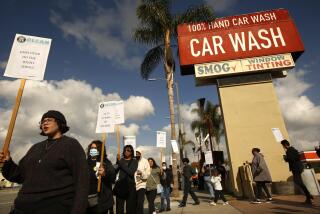Proposed NLRB rules are sensible and should be adopted
The embattled National Labor Relations Board has proposed rules to streamline union representation elections and give unions greater opportunity to contact workers. Employer representatives and conservative commentators have responded with vitriolic attacks. A Heritage Foundation analyst claims that “the NLRB’s proposed snap elections [are] another case of the Obama administration putting unions ahead of workers.”
These and similar comments reveal a basic hostility to the purposes of the National Labor Relations Act and a misconception, at best, of the NLRB’s role in enforcing it. The board’s proposed rules, which are the subject of a hearing in Washington this week, are sensible and should be adopted.
The National Labor Relations Act provides for elections, supervised by the NLRB, to determine if employees wish to unionize. In any unionization campaign, the employer, acting through lawyers and management officials, attempts to persuade employees to vote against unionization, while the union, acting through organizers and employee committees, seeks to persuade them of the benefits of union representation. The NLRB referees.
The board has been instructed by the U.S. Supreme Court to prevent an “imbalance in the opportunities for [union] organization communication,” and at the same time, it has been instructed that it may not grant union organizers the right to enter company property.
The result has been a system favorable to employers.
That’s because employers can gather the employees together, often during working hours, to convince them that voting for unionization would not be in their interest. Management will talk about debilitating strikes, union dues and the chancy nature of collective bargaining in what are known as “captive audience” meetings. It will assert its strenuous opposition to the union. Union representatives have no chance to respond “in kind”; they can’t speak at those events and must make their points at meetings away from the work site, during workers’ off time.
In a six-year study of union representation campaigns that I conducted with Northwestern University’s Stephen B. Goldberg and Jeanne Brett, we found that employees were far more familiar with company arguments against unionization than with arguments in favor of unionization. And this difference was based primarily on the fact that almost all employees (83%) attended one or more company meetings during unionization campaigns, but only a fraction (36%) attended union meetings.
The failure of employees to attend union meetings was not ideological. The most common reason for not attending was “held at an inconvenient time or place” (40%). We concluded that “when an employer uses company time and premises for anti-union campaigning and the union must campaign off company premises, the union is at a substantial disadvantage in communicating with the voters.” And those voters unfamiliar with the union’s campaign themes were more likely to vote against union representation.
Since we conducted our study, the employers’ advantage has become even greater. According to union organizers, captive-audience meetings are more and more common. And employers have also learned that delaying tactics, such as challenging the union’s proposed list of those eligible to vote for unionization, are easy to employ. Delays wear down employee militancy and willingness to take on the employer through a union.
The new rules the board is proposing will improve the balance between employer and union representatives, while staying within the limits imposed by the Supreme Court. They would make it easier for the union to get in touch with employees without entering company property. Currently, employers are required to furnish the union with the names and addresses of workers eligible to vote in the election. The new rules would require them to provide phone numbers and email addresses as well. The new rules would also speed up the process, primarily by postponing hearings on voter eligibility until after the elections.
Employer representatives claim that under the new rules they will not have an adequate chance to state the case against unionization. They claim to fear secret campaigns followed by hasty voting: “snap elections.”
That is fantasy. Usually, employers know that a campaign is underway almost immediately. Typically, they are informed by employees unfavorable to the union or by supervisors instructed to watch for whispering and gatherings. Besides, employers can and often do state their objections to unions when employees are first hired and at regular intervals thereafter.
Finally, under the proposed rules, there will be time — probably more than two weeks in most cases — after the union files its formal petition before the election is held. That period is available to the employer for anti-union campaigning.
The new rules aren’t radical; they are a step toward fairer representation elections.
What is radical is the way such modest proposals have been attacked. That they have drawn bitter condemnation shows the extent to which the NLRB and the National Labor Relations Act itself have become the target of right-wing critics.
Julius G. Getman is a labor law professor at the University of Texas at Austin. He has taught at Yale, the University of Chicago and Stanford. His latest book is “Restoring the Power of Unions: It Takes a Movement.”
More to Read
A cure for the common opinion
Get thought-provoking perspectives with our weekly newsletter.
You may occasionally receive promotional content from the Los Angeles Times.






